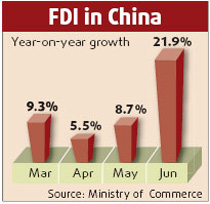Rapid urbanization as well as robust demand for homes will continue to boost the country's real estate industry in 2008, industry analysts said.
Wei Bo, a property analyst with Central China Securities Company, sees three main factors as being responsible for the strong demand.
"New demand from the country's urbanization progress, growing requirement for larger and better homes among the Chinese, as well as rising investments caused by the appreciation of the Chinese currency and the existing negative interest rates, will probably help the real estate industry's fortune for another year," Wei said.
"We expect the industry to maintain its high pace of development and give it a 'better than broad market' rating."
China is seeing probably one of the largest urbanization in the world. According to an earlier forecast by the United Nations, between 16 million and 22 million people will migrate from rural places to urban areas in the country each year from now to 2020. The total urban population will rise by 300 million at that time, which means an additional six billion square meters of housing will be needed.
Meanwhile, growing disposable income among the Chinese will further boost demand for new homes across the country.
In the first nine months of this year, disposable income for city dwellers expanded 13.2 percent to 10,346 yuan (US$1,398) and earnings for rural households rose 14.8 percent to 3,321 yuan, after being adjusted for rises in the consumer price index, the National Bureau of Statistics said in November.
The appreciating Chinese currency, which has so far gained about 10 percent since the yuan was depegged from the US dollar in July 2005, has been attracting speculative funds from overseas to invest in the country's property market.
For example, in Shanghai alone, the total value of en-bloc building acquisitions made during the first six months of this year has already reached 63 percent of 2006's total, according to an earlier report by Jones Lang LaSalle, one of the big five real estate service providers.
Moreover, the actual negative interest rate - meaning the one-year term deposit interest rate, after deducting inflation and interest tax, is below zero, or negative - has propelled more Chinese to invest in properties.
2nd-tier boom
A fundamental shift has occurred in the country's real estate market over the past year as investors and developers are increasingly looking toward the country's second-tier cities for new opportunities.
While construction continues in the first-tier cities of Shanghai, Beijing, Guangzhou and Shenzhen, the largest cities in the vast interior of the country are also witnessing rapid development and construction.
The residential sector has become an area of interest recently due to burgeoning home prices and the rapid pace of infrastructure construction.
In particular, Dalian, Chengdu and Hangzhou will in the near term become frontrunners to continue the strong trend of healthy residential development. Changsha, meanwhile, stands out as a market that is ready for higher quality projects.
Liaoning Province's Dalian, which boasts the best living environment in northeast China and is popular with South Korean and Japanese businessmen, is witnessing continuous expansion in its high-end residential properties whose capital values are growing rapidly.
Similarly, Chengdu in Sichuan Province saw a 22- percent rise in capital values between 2005 and 2006 while rents have been climbing for the past couple of years as foreign workers follow multinational companies into the city.
For Hangzhou, the draw is multi-faceted as it is famed for its natural scenery and boasts an enviable location near Shanghai. Moreover, it is the provincial capital of Zhejiang Province which has the highest per capita disposable income in China.
Meanwhile, Changsha, capital of Hunan Province, owing to its location between the regional hubs of Wuhan in the east and Chongqing in the west, stands to benefit greatly as developers move toward new markets. Prices for the city's residential properties have already gained more than 10 percent in the first and second quarters of this year.
Land supply
Listed real estate developers have been accelerating to expand their land banks across the country this year, mainly in the eastern Yangtze River delta region, the northern cities of Beijing and Tianjin and neighboring Hebei Province as well as southern Guangdong Province.
A recent study by China Securities Journal has found that of 86 land acquisition announcements issued so far this year on the country's two stock exchanges, about 70 percent are located in the above three regions, each of which secured 29, 16 and 15 deals.
In terms of capital spent, 22 listed real estate developers have spent a combined 38.32 billion yuan in 54 land acquisitions since July, a significant growth rate compared to 14.71 billion yuan spent jointly by 16 listed property developers in 32 deals in the first half of this year.
However, for the whole of 2006, a total sum of 15.88 billion yuan was spent in land acquisition deals by 17 listed real estate companies.
Among the listed real estate companies, Gemdale Group, Poly Real Estate Group Co and Tianjin Reality Development (Group) Co Ltd have been the most aggressive developers, enlarging their land reserves over the past five months as they contributed a combined 53.91 percent in terms of the total amount.
Specifically, Gemdale, the Chinese developer that is a partner of ING Groep NV, has purchased seven land plots for a total of 9.024 billion yuan July. Poly, China's largest state-owned developer, has spent 6.56 billion yuan to acquire seven land plots while Tianjin Reality has spent a total 5.073 billion yuan for five plots.
Nationwide, the average land prices increased 9.8 percent, 13.5 percent and 15 percent respectively in the first three quarters of this year, according to figures released by the China Real Estate Chamber of Commerce.
Major real estate players in China have been tapping the stock market to raise funds to expand their portfolios across the country as financing for property developments has been harder due to a tighter scrutiny on such projects.
(Shanghai Daily December 25, 2007)


